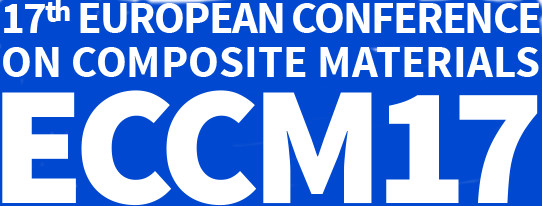

App-Einstellungen:
DAMAGE ANALYSIS FOR THERMAL LOADING INDUCED BY LASER IMPACT IN EPOXY COMPOSITE LAMINATE
Cédric Huchette (ONERA-The French aerospace Lab) Gillian Leplat (ONERA-The French aerospace Lab) Valentin Biasi (The French Aerospace Lab Toulouse)
The objective of this paper is to understand the damage scenario due to thermal loading in composite laminate. Thanks to an original experimental device and microscopic observation, the onset of delamination due to laser impact is discussed.
EVALUATION OF LIGHTNING RESISTANCE OF CHOPPED CARBON FIBER TAPE REINFORCED THERMOPLASTICS
Shinichiro Yamashita (University of Tokyo) Takeo Sonehara (Shoden Corporation) Jun Takahashi (University of Tokyo) Kazumasa Kawabe (Industrial Technology of Fukui Prefecture) Tetsuhiko Murakami (Industrial Technology of Fukui Prefecture)
A simulated lightning current was applied to chopped carbon fiber tape reinforced thermoplastics, which is a kind of ROS made by water dispersed prepreg tape. The damage behavior was characterized with high-speed camera and 3D measuring macroscope.
EXPERIMENTAL STUDY OF THE BURNING BEHAVIOUR OF A COMMERCIAL CARBON FIBRE COMPOSITE MATERIAL USED IN HIGH PRESSURE VESSELS
Juan P. Hidalgo (University of Edinburgh) Paolo Pironi (University of Edinburgh) Rory M. Hadden (University of Edinburgh) Stephen Welch (University of Edinburgh)
This paper presents an analysis on the charring rate experienced by a commercial CFRP material used to construct composite pressure vessels for hydrogen storage and transport applications.
HIGH TEMPERATURE COMPRESSIVE PROPERTIES OF CARBON EPOXY COMPOSITE LAMINATES
Julien Berthe (ONERA-The French aerospace Lab) Gérald Portemont (ONERA-The French aerospace Lab) Alain Deudon (ONERA-The French aerospace Lab) Matthieu Ragonet (ONERA-The French aerospace Lab)
This paper is dedicated to the experimental study of the evolution of the mechanical compressive properties of CRFP with the increase of the temperature from below Tg to above Tg.
INFLUENCE OF THE NUMBER, WEIGHT AND STACKING SEQUENCE OF METAL LAYERS ON THE FIRE PROPERTIES OF HYBRID CFRP-METAL COMPOSITES
Imke Roese-Koerner (German Aerospace Center) Benjamin Schuh (German Aerospace Center) Torsten Rinneberg Peter Wierach (German Aerospace Center)
An investigation of improved material solutions to mitigate fire, smoke and fumes in the event of a fire is presented. A number of hybrid CFRP-metal composites are inspected and their fire properties focusing on smoke production are evaluated.
LIGHTNING DAMAGE SUPPRESSION IN A CFRP WITH A POLYANILINE-BASED CONDUCTIVE THERMOSET MATRIX
Yoshiyasu Hirano (Japan Aerospace Exploration Agency) Tomohiro Yokozeki (University of Tokyo) Yuichi Ishida (Japan Aerospace Exploration Agency) Teruya Goto (Yamagata University) Tatsuhiro Takahashi (Yamagata University) Danna Wian (Mitsubishi Plastics Inc.) Shoji Itho (Mitsubishi Plastics Inc.) Toshio Ogasawara (Tokyo University of Agriculture and Technology) Masaru Ishibashi (GSI Creos Corporation)
The effectiveness of lightning damage suppression by a carbon-fiber-reinforced polymer (CFRP) laminate with polyaniline (PANI)-based conductive thermosetting resin was experimentally demonstrated by lightning tests and residual strength tests.
MODELLING OF THE DEGRADATION OF A CARBON-EPOXY COMPOSITE MATERIAL SUBMITTED TO A COUPLED THERMO-MECHANICAL LOAD
Camille Mercadé (Institute Pprime) Damien Halm (Institute Pprime) Thomas Rogaume (Université de Poitiers)
In this paper, a model coupling thermal degradation, heat transfers and mechanical behavior is presented, to model the phenomena occuring when a carbon-epoxy composite material is both submitted to high heat fluxes and to a mechanical loading.
THERMAL MODELLING OF EPOXY BASED INTUMESCENT COATINGS IN FIRE
Kai Yi (Aerospace Research Institute of Materials & Processing Technology) Wan Wan Jusoh (Newcastle University) Geoff Gibson (Newcastle University) George Kotsikos (Newcastle University) Sandra Christke (Newcastle University)
Mathematical modelling of heat transfer process and obtaining thermal information like time-temperature curve of in-house and commercially prepared epoxy based intumescent coating. The modelling predictions and the experimental results show a good agreement with each other.
A COMPREHENSIVE STRATEGY TO INCREASE THE OUT-OF-PLANE THERMAL CONDUCTIVITY OF CARBON FIBER COMPOSITES PROCESSED BY VACUUM ASSISTED RESIN TRANSFER MOLDING
Jens Schuster (Hochschule Kaiserslautern) Martin Schütz (Hochschule Kaiserslautern)
Design and modeling of thermal conductivity of carbon fiber reinforced plastics by introducing thermally high conductive vertical carbon fibers and aluminum particle loading of the matrix. The impregnation of the 3D-woven preform is done by VARTM.
CONDUCTIVITY IMPROVEMENT BY USING SILVER COATED KNITTING YARN IN NCF REINFORCED LAMINATES
Johannes Rehbein (German Aerospace Center)
Using silver coated knitting yarns increases the through-thickness conductivity of NCF-reinforced laminates to up to 540 S/m.
